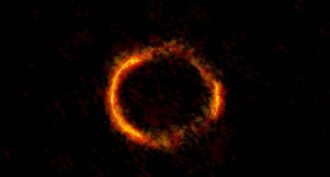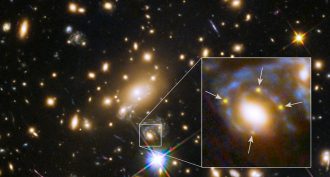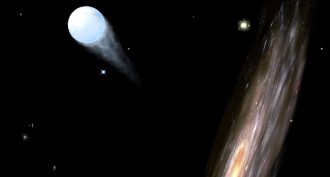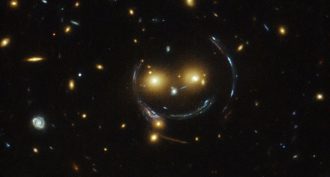Space

Educators and Parents, Sign Up for The Cheat Sheet
Weekly updates to help you use Science News Explores in the learning environment
Thank you for signing up!
There was a problem signing you up.
-
 Climate
ClimateCosmic rays offer clues about lightning
Space particles called cosmic rays pelt Earth. Scientists are using the rain of these particles to probe how lightning forms.
By Andrew Grant -
 Space
SpaceScientists Say: Gravitational lens
A gravitational lens is an effect that occurs when a massive object lies between a viewer and something further away. The massive object’s gravity bends light arriving from the more distant object.
-
 Space
SpaceRadio telescope picks up signals from intelligent life
Astronomers tracked down the source of perytons, mysterious radio bursts. They had at first seemed to emanate from Earth’s atmosphere. Probing now suggests the life forms responsible had a penchant for leftovers.
-
 Space
SpaceMini-sats: The trick to spying Earth-bound asteroids?
NASA is supposed to begin nonstop screening by 2020 for all asteroids that could pose a threat to Earth. Some astronomers now think the only way to affordably meet that deadline is by using mini-satellites
-
 Physics
PhysicsNew mirror picky in what it reflects
A new type of mirror is selective in the light it reflects. It allows some wavelengths of radiation to pass through, while others bounce off.
By Andrew Grant -
 Planets
PlanetsSomething’s cooking on Saturn’s moon
Grit in one of Saturn’s rings likely formed in hot water on the planet’s ice-covered moon Enceladus. That suggests conditions on this moon might be able to support life.
-
 Space
SpaceGalaxy cluster creates ‘magnifying glass’ in space
A massive galaxy’s gravity is so strong that it bends light, creating a “lens” in space. This natural magnifying glass is giving astronomers a rare view of a supernova on the other side of the universe.
By Ilima Loomis -
 Space
SpaceAstronomers spy fastest speeding star
A few stars have been spotted departing our galaxy. The fastest of these might have been propelled by another exploding star, a new study finds.
-
 Space
SpaceDust erases evidence of primordial gravity waves
In March 2014, scientists claimed to have found the first echoes of the Big Bang — ripples in the very fabric of space. A new analysis shows the experts were mistaken. Dust appears to explain the confusion.
By Andrew Grant -
 Space
SpacePicture This: Smiley face in space!
Ancients used to ‘see’ the outline of animals and other well-known things as constellations in the night sky. Now astronomers have done much the same thing. But they’ve spotted a more distant — if totally modern — shape: a smiley face!
By Janet Raloff -
 Physics
PhysicsMachine simulates the sun’s core
A machine heats iron atoms to temperatures that match the interior of the sun. This has helped solve a solar mystery.
By Ilima Loomis -
 Space
SpaceBlack holes are on collision course
But be patient. The distant galactic smashup is still some million years away.